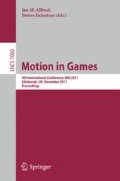Abstract
Reconstruction is a key step of the motion capture process. The quality of motion data first results from the quality of raw data. However, it also depends on the motion reconstruction step, especially when raw data suffer markers losses or noise due, for example, to challenging conditions of capture. Labeling is a final and crucial data reconstruction step that enables practical use of motion data (e.g., analysis). The lower the data quality, the more time consuming and tedious the labeling step, because human intervention cannot be avoided: he has to manually indicate markers label each time a loss of the marker in time occurs. In the context of crowd study, we faced such situation when we performed experiments on the locomotion of groups of people. Data reconstruction poses several problems such as markers labeling, interpolation and mean position computation. While Vicon IQ software has difficulties to automatically label markers for the crowd experiment we carried out, we propose a specific method to label our data and estimate participants mean positions with incomplete data.
Access this chapter
Tax calculation will be finalised at checkout
Purchases are for personal use only
Preview
Unable to display preview. Download preview PDF.
References
Chai, J., Hodgins, J.K.: Performance animation from low-dimensional control signals. ACM Trans. Graph. 24, 686–696 (2005)
Courty, N., Cuzol, A.: Conditional stochastic simulation for character animation. Computer Animation and Virtual Worlds 21, 443–452 (2010)
Daamen, W., Hoogendoorn, S.P.: Qualitative results from pedestrian laboratory experiments. In: Pedestrian and Evacuation Dynamics (2003)
Dorfmller-Ulhaas, K.: Robust optical user motion tracking using a kalman filter. Tech. rep., Universittsbibliothek der Universitt Augsburg (2003)
Herda, L., Fua, P., Plänkers, R., Boulic, R., Thalmann, D.: Skeleton-based motion capture for robust reconstruction of human motion. Comp. Animation, 77 (2000)
Kretz, T., Grnebohm, A., Schreckenberg, M.: Experimental study of pedestrian flow through a bottleneck. Journal of Statistical Mechanics: Theory and Experiment, 10014 (2006)
Li, L., McCann, J., Pollard, N., Faloutsos, C.: Bolero: a principled technique for including bone length constraints in motion capture occlusion filling. In: Proceedings of ACM SIGGRAPH/Eurographics Symposium on Computer Animation (2010)
Pettré, J., Ondřej, J., Olivier, A.H., Cretual, A., Donikian, S.: Experiment-based modeling, simulation and validation of interactions between virtual walkers. In: Proceedings of ACM SIGGRAPH/Eurographics Symposium on Computer Animation (2009)
Seyfried, A., Passon, O., Steffen, B., Boltes, M., Rupprecht, T., Klingsch, W.: New insights into pedestrian flow through bottlenecks. Transportation Science 43, 395–406 (2009)
Still, G.: Crowd dynamics. Ph.D. thesis, University of Warwick, UK (2000)
Taylor, G.W., Hinton, G.E., Roweis, S.: Modeling human motion using binary latent variables. In: Advances in Neural Information Processing Systems (2006)
Yamori, K.: Going with the flow: Micro-macro dynamics in the macrobehavioral patterns of pedestrian crowds. Psychological Review 105, 530–557 (1998)
Author information
Authors and Affiliations
Editor information
Editors and Affiliations
Rights and permissions
Copyright information
© 2011 Springer-Verlag Berlin Heidelberg
About this paper
Cite this paper
Lemercier, S., Moreau, M., Moussaïd, M., Theraulaz, G., Donikian, S., Pettré, J. (2011). Reconstructing Motion Capture Data for Human Crowd Study. In: Allbeck, J.M., Faloutsos, P. (eds) Motion in Games. MIG 2011. Lecture Notes in Computer Science, vol 7060. Springer, Berlin, Heidelberg. https://doi.org/10.1007/978-3-642-25090-3_31
Download citation
DOI: https://doi.org/10.1007/978-3-642-25090-3_31
Publisher Name: Springer, Berlin, Heidelberg
Print ISBN: 978-3-642-25089-7
Online ISBN: 978-3-642-25090-3
eBook Packages: Computer ScienceComputer Science (R0)

